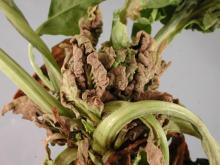By O. Neher and C. M. Ocamb (Group M1)
Cause The fungus-like microorganism, Peronospora farinosa f. sp. betae (formerly P. schachtii) , causes disease on sugar beet for seed mostly west of the Cascade Range. The microorganism survives in infected crop residues and in wild or volunteer Beta spp. It can also survive in seed to a limited extent. Optimal temperatures for infection are between 45°F and 59°F; little infection occurs above 68°F.
Symptoms All aboveground plant parts may be affected. Large, light green leaf spots develop on the upper leaf surfaces. Under moist conditions, a white to gray mold appears on the lower or upper leaf surfaces. Affected leaves may wilt, and then die. If environmental conditions become unfavorable for downy mildew, plants may show recovery by developing healthy leaves, or other pathogens may be encouraged. During fall wet periods, most young petioles or leaves are covered with a mycelial growth that often moves into the crown. Crown infections may permit other root-decay organisms to invade the plant. Crown infection causes excessive leaf proliferation, which in turn causes misshapen bulbs.
In beet seed crops, systemic crown infections of stecklings may result in severe stand and seed yield losses. Flower and seed heads can be attacked directly with serious losses of seed production.
Cultural control
- Increase plant spacing, and avoid excess nitrogen.
Chemical control In sugar beet seed crops, steckling beds should receive protective sprays. No effective controls are available for seed head infection.
- C-O-C-S WDG (Group M1) at 2 to 2.5 lb/A in at least 25 gal water/A (ground) or 5 gal water/A (air). Is labeled for use for other diseases and will help to control downy mildew. 24-hr reentry.
- Dithane F45 Rainshield at 1.2 to 1.6 quarts/A on 7- to 10-day intervals is labeled for a different disease and can used for downy mildew control in Oregon only. Do not feed treated tops to livestock. 24-hr reentry.
- Fosphite (Group P7) at 1 to 3 quart/A on 2- to 4-week intervals, depending on rate. 4-hr reentry.
- Trilogy at 0.5% to 1%. Not labeled for use in Oregon. Do not use above 90°F or when plants are under heat or moisture stress. Do not use when foliage is wet as good coverage is essential. Poor control as a stand-alone product. 4-hr reentry. O
The following formulations are labeled for sugar beet seed production only:
- Bravo Ultrex (Group M5) at 1.6 lb/A or Bravo Weather Stik at 1.7 pints/A for Oregon sugar beet seed production only (SLN OR-180009, SLN OR-180008). Do not apply to plants after bolting and seedhead emergence. 12-hr reentry.
Reference Harveson, R.M., Hanson, L.E., and Hein, G.L. 2009. Compendium of Beet Diseases and Insects. 2nd Edition. St. Paul, MN: APS Press.


